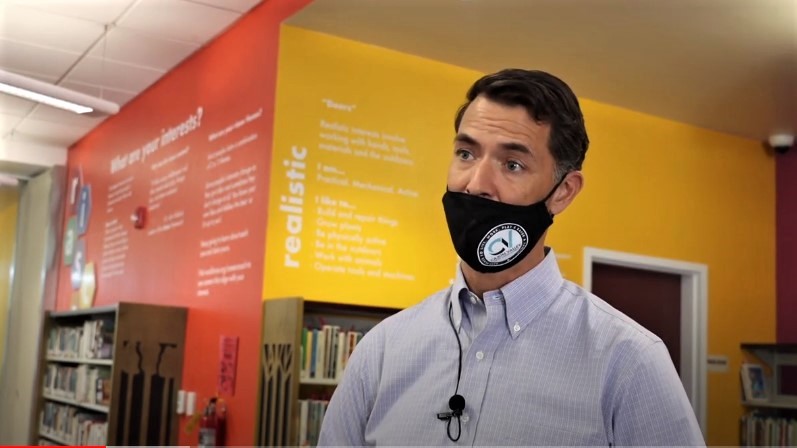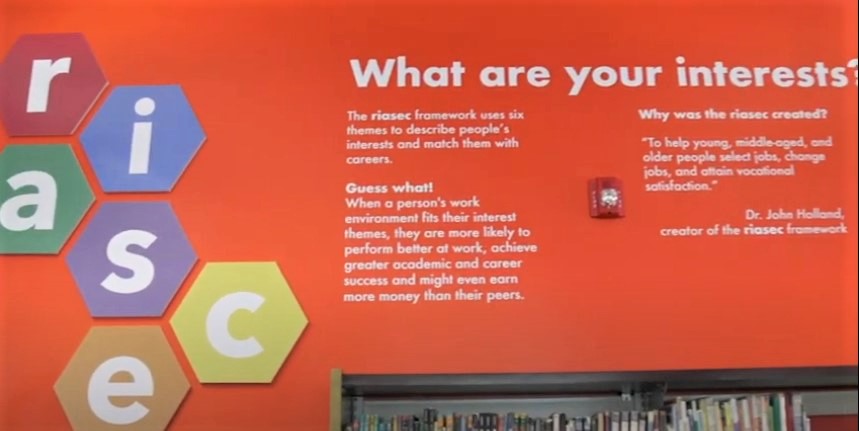The writing is on the walls of the library at Cajon Valley Middle School in California. For students and their parents, it shows the future and the paths to get there, along with six letters that can help it all make sense: RIASEC.
The imaginative “quasi museum, art installation” space is the creative vision of Ed Hidalgo, the Chief of Innovation and Engagement Officer for the Cajon Valley Union School District and several projects partners. When he was at Qualcomm 20 years ago, he had an idea to build a maker space for middle school students to learn about the World of Work.
Behold the Launch Pad.
Colored wall panels and dynamic graphics showcase the true art – information and charts at a variety of workstations where students and parents can think about who they are, where they want to go, and the tracks that can take them there. The idea isn’t new to Cajon Valley – a career development framework has been in place for three and a half years – but the space is and it brings together all of the elements to help those who enter it see the road ahead more clearly.
“The Launch Pad is really just an extension of what we’ve been doing; it brings another level of legitimacy to the work in a space that is sometimes underutilized for much of the day,” Hidalgo says. “You have these beautiful experiences that we do in different modalities in the classroom, but now they’re up on the walls. You can experience these missions and go to these stations. The teacher, library media tech or counselor can be involved with reflection exercises, which are really where the rubber meets the road – as kids make connections between who they are and who they want to become.”
And yes, learn their “letters” and what the RIASEC developed by Dr. John Holland tells them their about their interests – whether they are Realistic, Investigative, Artistic, Social, Enterprising or Conventional, or a combination of some – in order to provide a more clearer picture of who they truly are. From there, it’s game on as they learn more skills that can put them on a real, enjoyable path to success.
The beauty of the Launch Pad is it not only provides a framework for El Cajon’s young learners but also a structure for parents, who can use the same elements, the same core skills as their children, to find their own paths. And because of partnerships with the San Diego Workforce Partnership, the Office of Federal Student Aid and American Student Assistance – they too can make their dreams come true.
“Anyone from K to gray can enjoy this,” Hidalgo says. “I use the same exact framework. We have to first understand you. What are your strengths, interests and values? What academic and career journeys have you been exposed to? If I’m someone with a job offer, can you tell your story to me, so that I would want to say yes to you? If you can’t do all those things, it’s going to be really hard for you to progress.”
CLICK IMAGE TO SEE THE LAUNCH PAD IN ACTION

The Mission of Me
Hidalgo has spoken all over the world on his bold ideas and has several principals interested in borrowing elements and ideas about the Launch Pad to implement in their own schools. A thoughtful and extremely articulate leader, he says the journey to get on the right path can start very young. In the Launch Pad, the idea behind this Mission of Me focuses on “self-awareness, exploration, and every child being able to tell their story.”
Typically, the first stop on the journey – after picking up a packet that discusses potential missions – is to the RIASEC lounge, which explores students’ interests. They can self-report their themes or play a card game where they can guess the RIASEC theme of famous people so they can discuss their strengths and interests.
From there, it’s on to the Me Tree, a corner area featuring the silhouette of a large tree and branches on the wall.
“Essentially, in the roots of the tree, you place your strengths and values,” Hidalgo says. “In the trunk, you place your interests. Up in the canopy, you start to identify your hopes and dreams and your fears and doubts. You kind of have to know what you don’t want to be in order to know what you want to be.”
There are stations around potential paths – such as two-year and four-year college options and the importance of the FAFSA – and then priority sector boards that contain employer information at the bottom. One of the centerpieces of the space is a giant wall map where students can see the location of those employers to see how to make that path a reality to getting hired. Many times, Hidalgo says, students can’t see past their own neighborhoods.
“So we ask them, what would it actually take to get there?,” he says. “If you have to take public transportation, how would you get there? And they look at me like, that’s not far away. Before we started doing this World of Work, every child in my class wanted to go work at the Jack in the Box [restaurant]. They wanted to work there because it was only a quarter of a mile away.”
Changing the mindset
Starting young and providing this type of eye-opening experience is essential in El Cajon. Some 30% of its population are refugee families. The school district has 13 liaisons that go into the community to engage with citizens in a variety of dialects including Arabic, Pashto, Farsi and Swahili. They run the gamut of having high SES to very low SES. Some are located in the Valley and some are in the rim above it.
“We have a wonderfully diverse population of students,” Hidalgo says.
Few middle schoolers, or even high schoolers, have their futures figured out. Hidalgo believes students should pursue their goals that align with their interests and should not be automatically painted into STEM-focused or CTE-driven models.
“We push STEM beyond what it should be,” he says. “Because the world needs other professions. They might use some aspects of STEM, but they don’t have to be software developers. I always wanted to create a space that was for every child and that would align to every child’s interests and hopes and dreams. I think this is the space that gives us that opportunity.
“I’m not trying to prepare talent for the employers here, I’m trying to prepare the right human. And the right human is someone who has the right talents, but also understands their strengths, interests and values.”
This is the second makerspace Hidalgo has developed. But other similar ones have sprouted up at Michigan and Virginia Tech. With his space in El Cajon, he is allowing those missions to start earlier.
“I’ve talked to a lot of people who when they reflect on it, say it was around middle school where they met someone and got exposure to something that kind of lit that fire,” he says.
For some of those who live in El Cajon, giving this opportunity to their children for self-reflection is truly priceless.
“One family that was homeless that we were working with, we asked them for some feedback,” Hidalgo says. “They were trying to express it to us – thank you for what you’re doing because we can’t do this for out kids. It just brings tears to your eyes. Each one of these parents says the same thing: I wish I’d had this when I was their age.”








